ECH113 - Play and Inquiry: Learning Potential in Early Childhood
VerifiedAdded on 2023/06/11
|7
|2150
|180
Essay
AI Summary
This essay explores the significance of play in early childhood education, focusing on its potential for learning and development. It analyzes a play scenario involving four preschool boys engaged in constructing an imaginary sausage shop, highlighting the roles of creative thinking and physical activity. The essay discusses how the children's collaborative efforts, problem-solving, and imaginative role-playing contribute to their cognitive, social, and emotional growth. It emphasizes the importance of educators in facilitating and enhancing play-based learning experiences. The essay concludes by suggesting strategies for enriching children's play, such as incorporating arithmetic learning through sales activities and promoting the use of natural resources for creative shop decoration. Desklib provides access to a wealth of similar solved assignments and resources for students.
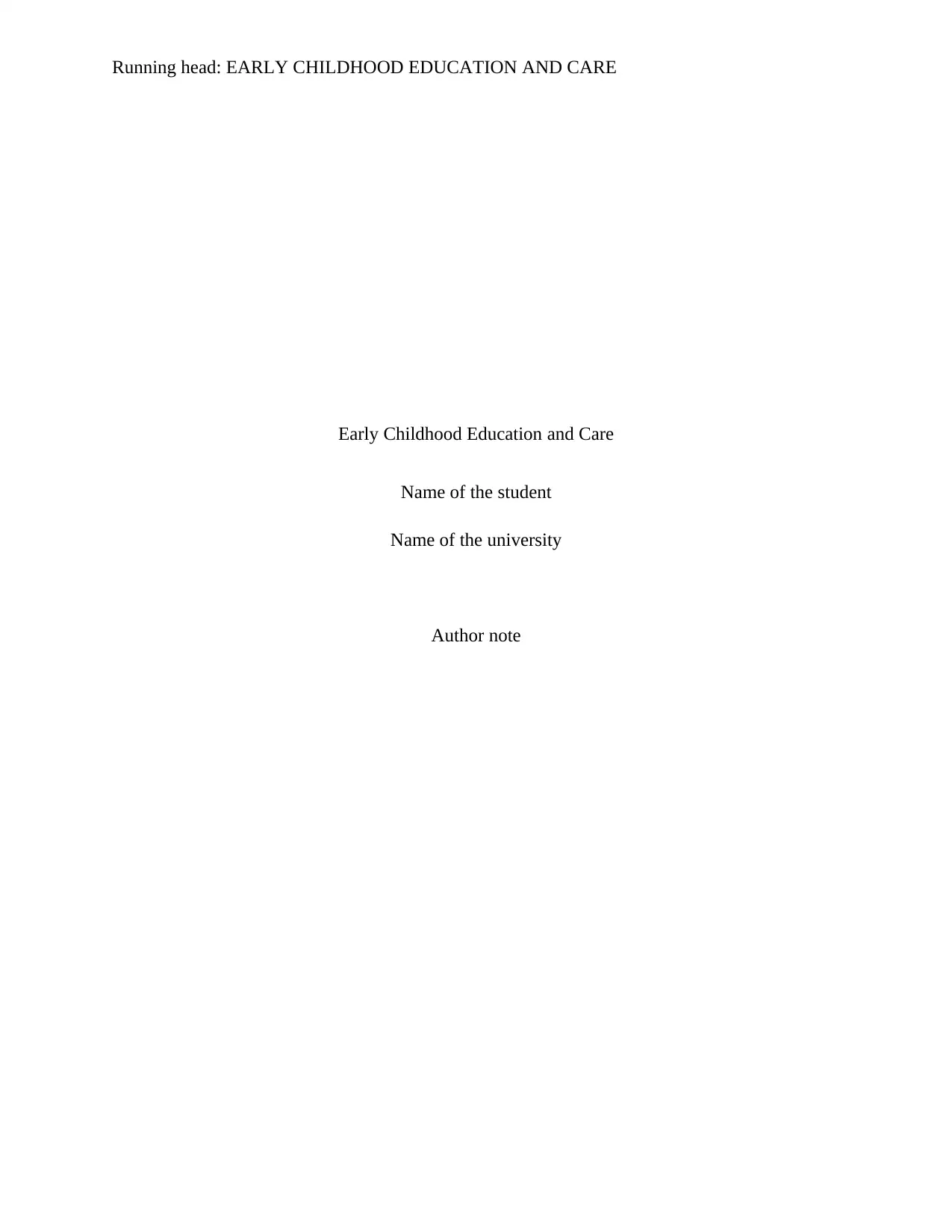
Running head: EARLY CHILDHOOD EDUCATION AND CARE
Early Childhood Education and Care
Name of the student
Name of the university
Author note
Early Childhood Education and Care
Name of the student
Name of the university
Author note
Paraphrase This Document
Need a fresh take? Get an instant paraphrase of this document with our AI Paraphraser
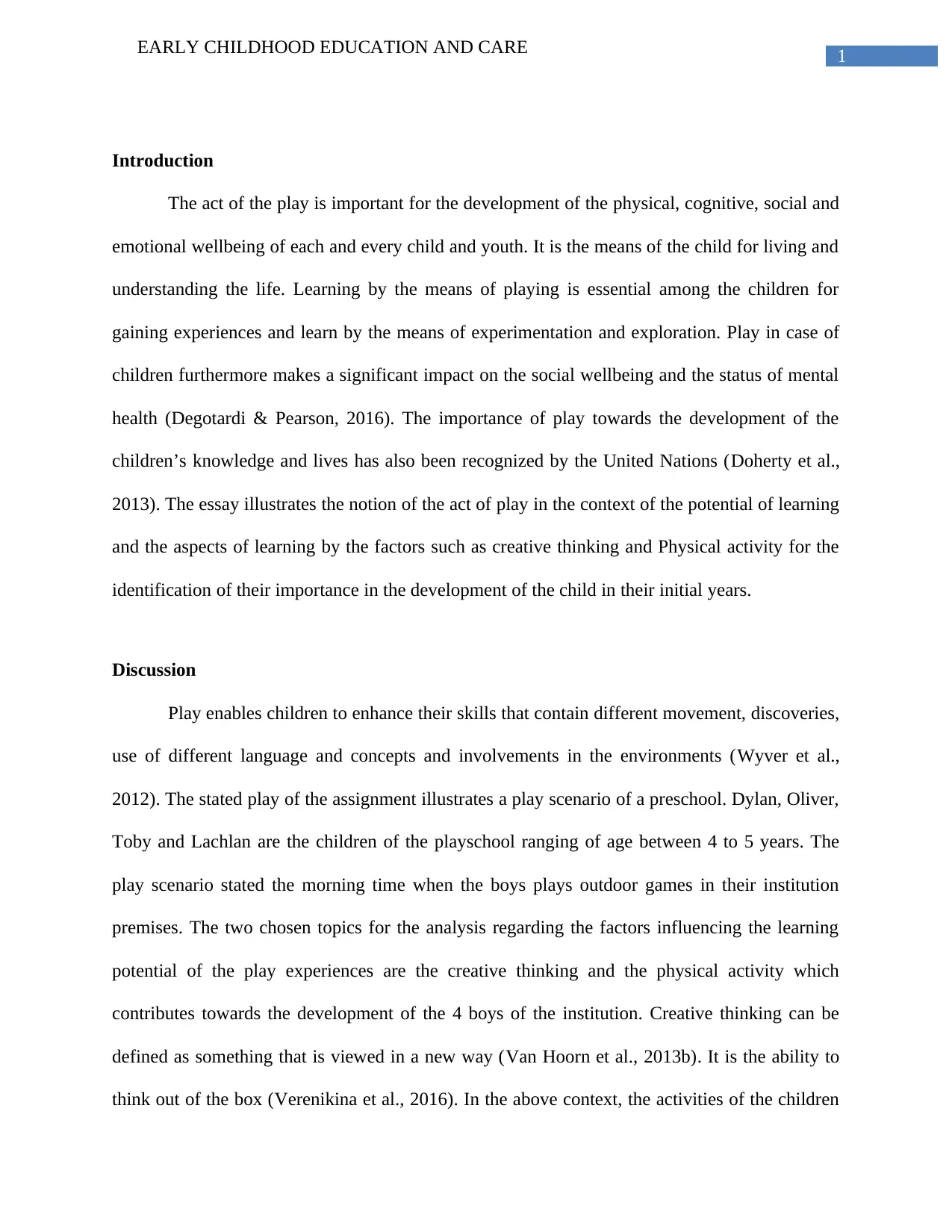
1EARLY CHILDHOOD EDUCATION AND CARE
Introduction
The act of the play is important for the development of the physical, cognitive, social and
emotional wellbeing of each and every child and youth. It is the means of the child for living and
understanding the life. Learning by the means of playing is essential among the children for
gaining experiences and learn by the means of experimentation and exploration. Play in case of
children furthermore makes a significant impact on the social wellbeing and the status of mental
health (Degotardi & Pearson, 2016). The importance of play towards the development of the
children’s knowledge and lives has also been recognized by the United Nations (Doherty et al.,
2013). The essay illustrates the notion of the act of play in the context of the potential of learning
and the aspects of learning by the factors such as creative thinking and Physical activity for the
identification of their importance in the development of the child in their initial years.
Discussion
Play enables children to enhance their skills that contain different movement, discoveries,
use of different language and concepts and involvements in the environments (Wyver et al.,
2012). The stated play of the assignment illustrates a play scenario of a preschool. Dylan, Oliver,
Toby and Lachlan are the children of the playschool ranging of age between 4 to 5 years. The
play scenario stated the morning time when the boys plays outdoor games in their institution
premises. The two chosen topics for the analysis regarding the factors influencing the learning
potential of the play experiences are the creative thinking and the physical activity which
contributes towards the development of the 4 boys of the institution. Creative thinking can be
defined as something that is viewed in a new way (Van Hoorn et al., 2013b). It is the ability to
think out of the box (Verenikina et al., 2016). In the above context, the activities of the children
Introduction
The act of the play is important for the development of the physical, cognitive, social and
emotional wellbeing of each and every child and youth. It is the means of the child for living and
understanding the life. Learning by the means of playing is essential among the children for
gaining experiences and learn by the means of experimentation and exploration. Play in case of
children furthermore makes a significant impact on the social wellbeing and the status of mental
health (Degotardi & Pearson, 2016). The importance of play towards the development of the
children’s knowledge and lives has also been recognized by the United Nations (Doherty et al.,
2013). The essay illustrates the notion of the act of play in the context of the potential of learning
and the aspects of learning by the factors such as creative thinking and Physical activity for the
identification of their importance in the development of the child in their initial years.
Discussion
Play enables children to enhance their skills that contain different movement, discoveries,
use of different language and concepts and involvements in the environments (Wyver et al.,
2012). The stated play of the assignment illustrates a play scenario of a preschool. Dylan, Oliver,
Toby and Lachlan are the children of the playschool ranging of age between 4 to 5 years. The
play scenario stated the morning time when the boys plays outdoor games in their institution
premises. The two chosen topics for the analysis regarding the factors influencing the learning
potential of the play experiences are the creative thinking and the physical activity which
contributes towards the development of the 4 boys of the institution. Creative thinking can be
defined as something that is viewed in a new way (Van Hoorn et al., 2013b). It is the ability to
think out of the box (Verenikina et al., 2016). In the above context, the activities of the children

2EARLY CHILDHOOD EDUCATION AND CARE
showed their critical thought process. The children in the play plans to build up an imaginary
sausage shop which they see in their day to day life and initiated to put up a play to act like the
cooker and the butcher after constructing the imaginary shop. They firstly worked
collaboratively to carry out the bricks, large block and the logs from the verandah of their
institution to the busy outside area which was about 20 meters away. The strong eagerness to
build something with the blocks and the logs were immense among the children and they
together with efficient teamwork moved the blocks from the verandah. Ethan directed the others
to use the wheelbarrow for carrying the larger blocks and they somehow successfully managed to
shift all the raw materials. Another important factor that contributes to the analysis of the
learning potential in this context is the physical activity. Physical activity is the movement of
body with the effective usage of energy (Adolph & Robinson, 2015). The notion of physical
activity is extremely important among the children since it helps the children to maintain a
healthy body weight, strengthens the bones of the child, decreases the risk of various types of
diseases and problems related to health and boost up their self esteem (Schmitt et al., 2017). In
the above context, the 4 boys who planned to construct a shop by the means of the bricks and the
logs in the outdoor area included loads of hard work. The tireless movement of the children
between the two locations resulted in the formation of real drops of sweat on their brows and
they got exhausted after this tremendous physical activity. This activity was beneficial for the
children to boost up their encouragement to build the shop and made them more flexible
(McDonald, 2018). Ethan wanted to construct an airport initially but agreed with the decisions of
the other boys to build a shop like the one the other boys made a week before. The boys started
working together for constructing the structure of their shop. From trailing with different shapes
of bricks for the wall to discussing about the requirements to construct each and every detail
showed their critical thought process. The children in the play plans to build up an imaginary
sausage shop which they see in their day to day life and initiated to put up a play to act like the
cooker and the butcher after constructing the imaginary shop. They firstly worked
collaboratively to carry out the bricks, large block and the logs from the verandah of their
institution to the busy outside area which was about 20 meters away. The strong eagerness to
build something with the blocks and the logs were immense among the children and they
together with efficient teamwork moved the blocks from the verandah. Ethan directed the others
to use the wheelbarrow for carrying the larger blocks and they somehow successfully managed to
shift all the raw materials. Another important factor that contributes to the analysis of the
learning potential in this context is the physical activity. Physical activity is the movement of
body with the effective usage of energy (Adolph & Robinson, 2015). The notion of physical
activity is extremely important among the children since it helps the children to maintain a
healthy body weight, strengthens the bones of the child, decreases the risk of various types of
diseases and problems related to health and boost up their self esteem (Schmitt et al., 2017). In
the above context, the 4 boys who planned to construct a shop by the means of the bricks and the
logs in the outdoor area included loads of hard work. The tireless movement of the children
between the two locations resulted in the formation of real drops of sweat on their brows and
they got exhausted after this tremendous physical activity. This activity was beneficial for the
children to boost up their encouragement to build the shop and made them more flexible
(McDonald, 2018). Ethan wanted to construct an airport initially but agreed with the decisions of
the other boys to build a shop like the one the other boys made a week before. The boys started
working together for constructing the structure of their shop. From trailing with different shapes
of bricks for the wall to discussing about the requirements to construct each and every detail
⊘ This is a preview!⊘
Do you want full access?
Subscribe today to unlock all pages.

Trusted by 1+ million students worldwide

3EARLY CHILDHOOD EDUCATION AND CARE
inside the shop, the 4 boys started the construction in a well balanced manner. The boys
continued to gather their additional resources with the aim to build up a sausage shop from which
they can gate lots of money. The children imagined themselves to be the real shop holders and
their critical thinking enabled them to play certain roles like the cooks, cashier and more. This
particular process is essential since it helps children to develop and stimulate their mind to think
something out of the box, to dream big and to grow up the urge to achieve something good in
their life (Broadhead, 2010). They imagined some of the small blocks in their hotplates as
sausages and pretended to sell them just like the scenario of a real meat shop. The activity
vividly portrayed how the 4 boys liked the mechanism of a meat shop and imagined themselves
in a real scenario. Furthermore they acted as the real sellers by shouting for sale of their
imaginary sausages, which represents their notion of critical imagination and thought process.
Children from other units also gathered and participated in the play quickly as the customers.
The educator encouraged their role play and their hard work of constructing their own sausage
selling shop and exchanges a few stones with their imaginary sausages. Furthermore to boost up
their selling role the educator asked for the change and Ethan quickly responded with some of
the stones as a token for exchange. This act of him portrayed his level of intelligence and critical
thoughts that developed while playing the meat shop. With an unconfident writing skill and
unusual grip, Toby still managed to write the sign of their shop with the assistance of the
educator which showed the level of enthusiasm and the urge to gain more knowledge and skills
among the child.
The act of sausage shop by the four children illustrated two of the most important factors
namely the process of critical thinking and the hard work by them. The play helped in
stimulating the learning experience of the 4 children and they drew satisfaction of their emotions
inside the shop, the 4 boys started the construction in a well balanced manner. The boys
continued to gather their additional resources with the aim to build up a sausage shop from which
they can gate lots of money. The children imagined themselves to be the real shop holders and
their critical thinking enabled them to play certain roles like the cooks, cashier and more. This
particular process is essential since it helps children to develop and stimulate their mind to think
something out of the box, to dream big and to grow up the urge to achieve something good in
their life (Broadhead, 2010). They imagined some of the small blocks in their hotplates as
sausages and pretended to sell them just like the scenario of a real meat shop. The activity
vividly portrayed how the 4 boys liked the mechanism of a meat shop and imagined themselves
in a real scenario. Furthermore they acted as the real sellers by shouting for sale of their
imaginary sausages, which represents their notion of critical imagination and thought process.
Children from other units also gathered and participated in the play quickly as the customers.
The educator encouraged their role play and their hard work of constructing their own sausage
selling shop and exchanges a few stones with their imaginary sausages. Furthermore to boost up
their selling role the educator asked for the change and Ethan quickly responded with some of
the stones as a token for exchange. This act of him portrayed his level of intelligence and critical
thoughts that developed while playing the meat shop. With an unconfident writing skill and
unusual grip, Toby still managed to write the sign of their shop with the assistance of the
educator which showed the level of enthusiasm and the urge to gain more knowledge and skills
among the child.
The act of sausage shop by the four children illustrated two of the most important factors
namely the process of critical thinking and the hard work by them. The play helped in
stimulating the learning experience of the 4 children and they drew satisfaction of their emotions
Paraphrase This Document
Need a fresh take? Get an instant paraphrase of this document with our AI Paraphraser
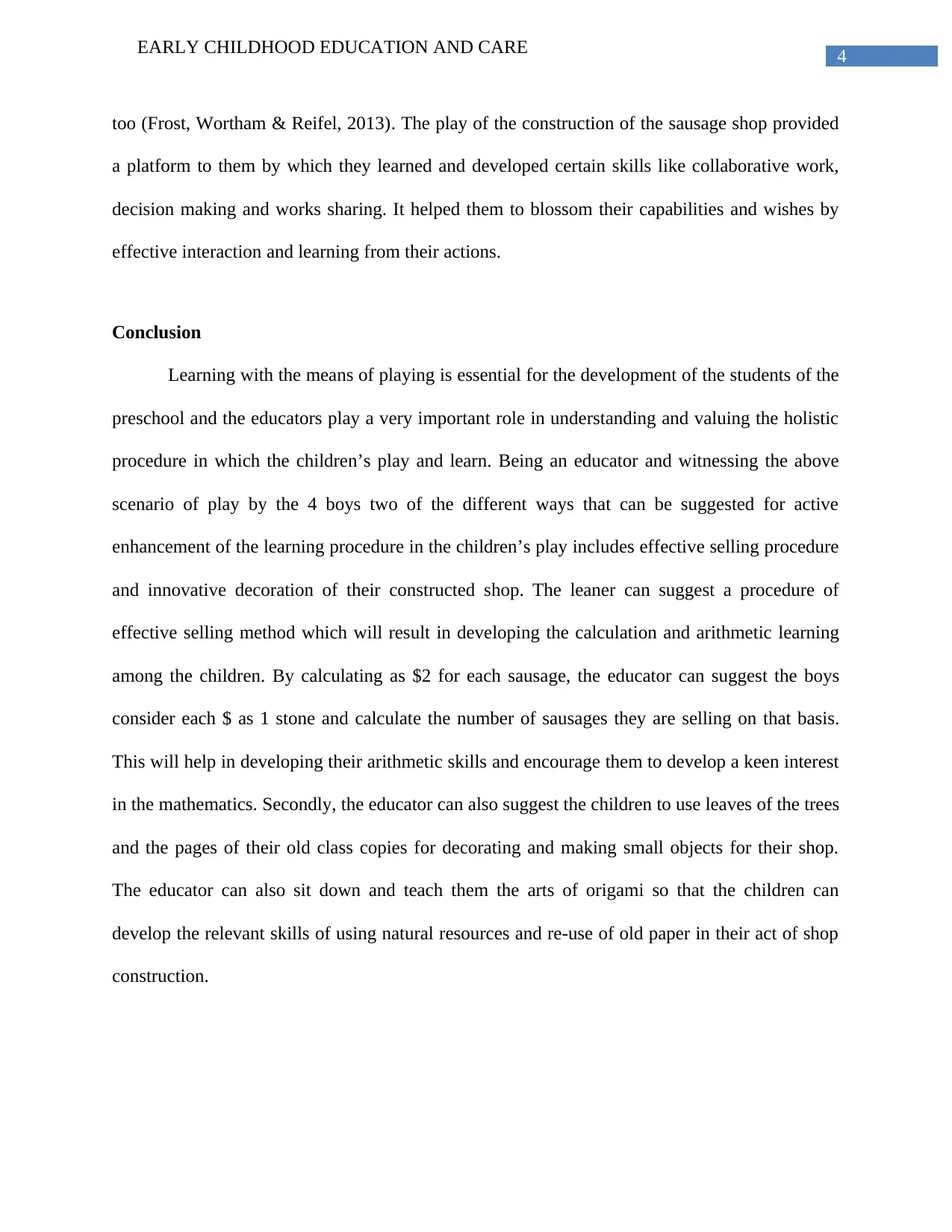
4EARLY CHILDHOOD EDUCATION AND CARE
too (Frost, Wortham & Reifel, 2013). The play of the construction of the sausage shop provided
a platform to them by which they learned and developed certain skills like collaborative work,
decision making and works sharing. It helped them to blossom their capabilities and wishes by
effective interaction and learning from their actions.
Conclusion
Learning with the means of playing is essential for the development of the students of the
preschool and the educators play a very important role in understanding and valuing the holistic
procedure in which the children’s play and learn. Being an educator and witnessing the above
scenario of play by the 4 boys two of the different ways that can be suggested for active
enhancement of the learning procedure in the children’s play includes effective selling procedure
and innovative decoration of their constructed shop. The leaner can suggest a procedure of
effective selling method which will result in developing the calculation and arithmetic learning
among the children. By calculating as $2 for each sausage, the educator can suggest the boys
consider each $ as 1 stone and calculate the number of sausages they are selling on that basis.
This will help in developing their arithmetic skills and encourage them to develop a keen interest
in the mathematics. Secondly, the educator can also suggest the children to use leaves of the trees
and the pages of their old class copies for decorating and making small objects for their shop.
The educator can also sit down and teach them the arts of origami so that the children can
develop the relevant skills of using natural resources and re-use of old paper in their act of shop
construction.
too (Frost, Wortham & Reifel, 2013). The play of the construction of the sausage shop provided
a platform to them by which they learned and developed certain skills like collaborative work,
decision making and works sharing. It helped them to blossom their capabilities and wishes by
effective interaction and learning from their actions.
Conclusion
Learning with the means of playing is essential for the development of the students of the
preschool and the educators play a very important role in understanding and valuing the holistic
procedure in which the children’s play and learn. Being an educator and witnessing the above
scenario of play by the 4 boys two of the different ways that can be suggested for active
enhancement of the learning procedure in the children’s play includes effective selling procedure
and innovative decoration of their constructed shop. The leaner can suggest a procedure of
effective selling method which will result in developing the calculation and arithmetic learning
among the children. By calculating as $2 for each sausage, the educator can suggest the boys
consider each $ as 1 stone and calculate the number of sausages they are selling on that basis.
This will help in developing their arithmetic skills and encourage them to develop a keen interest
in the mathematics. Secondly, the educator can also suggest the children to use leaves of the trees
and the pages of their old class copies for decorating and making small objects for their shop.
The educator can also sit down and teach them the arts of origami so that the children can
develop the relevant skills of using natural resources and re-use of old paper in their act of shop
construction.
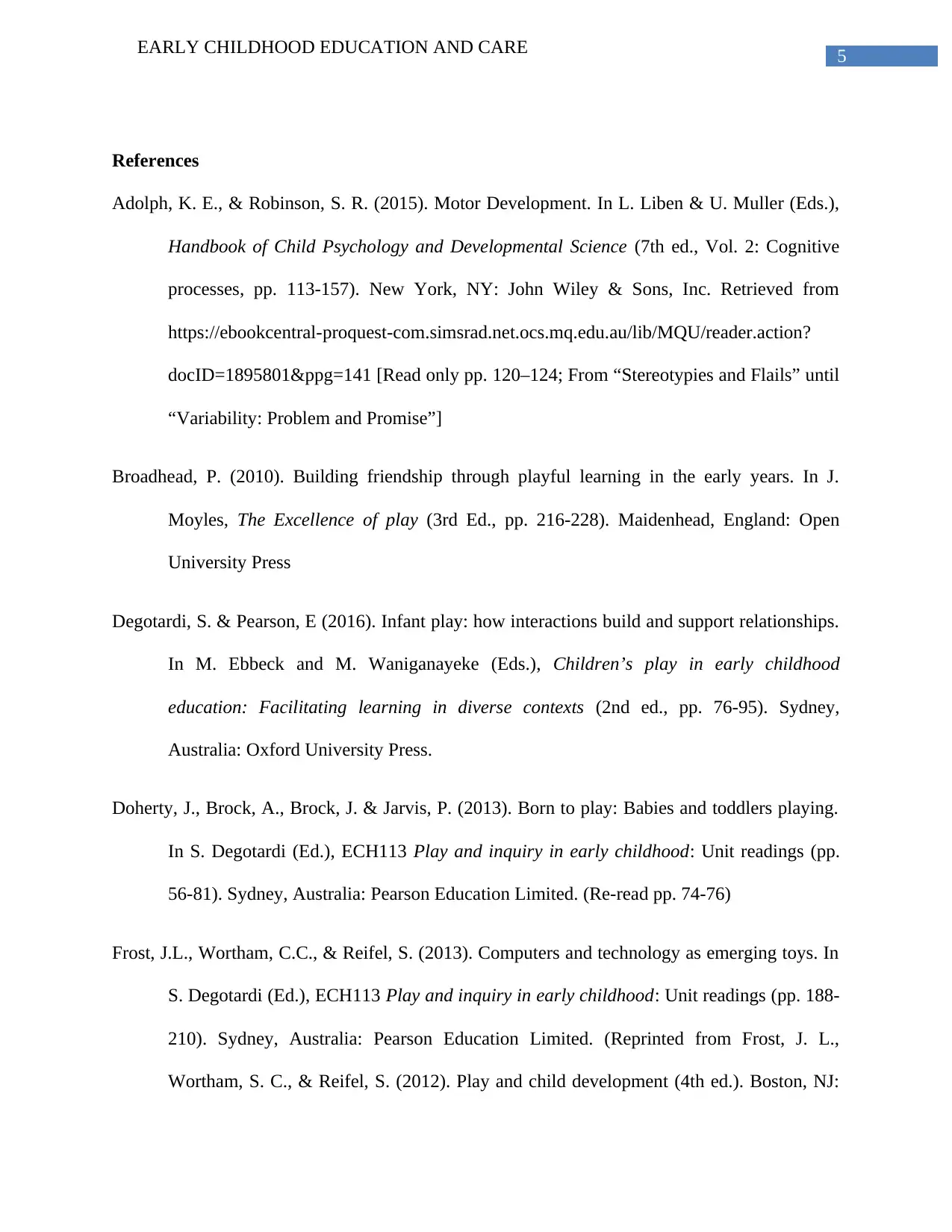
5EARLY CHILDHOOD EDUCATION AND CARE
References
Adolph, K. E., & Robinson, S. R. (2015). Motor Development. In L. Liben & U. Muller (Eds.),
Handbook of Child Psychology and Developmental Science (7th ed., Vol. 2: Cognitive
processes, pp. 113-157). New York, NY: John Wiley & Sons, Inc. Retrieved from
https://ebookcentral-proquest-com.simsrad.net.ocs.mq.edu.au/lib/MQU/reader.action?
docID=1895801&ppg=141 [Read only pp. 120–124; From “Stereotypies and Flails” until
“Variability: Problem and Promise”]
Broadhead, P. (2010). Building friendship through playful learning in the early years. In J.
Moyles, The Excellence of play (3rd Ed., pp. 216-228). Maidenhead, England: Open
University Press
Degotardi, S. & Pearson, E (2016). Infant play: how interactions build and support relationships.
In M. Ebbeck and M. Waniganayeke (Eds.), Children’s play in early childhood
education: Facilitating learning in diverse contexts (2nd ed., pp. 76-95). Sydney,
Australia: Oxford University Press.
Doherty, J., Brock, A., Brock, J. & Jarvis, P. (2013). Born to play: Babies and toddlers playing.
In S. Degotardi (Ed.), ECH113 Play and inquiry in early childhood: Unit readings (pp.
56-81). Sydney, Australia: Pearson Education Limited. (Re-read pp. 74-76)
Frost, J.L., Wortham, C.C., & Reifel, S. (2013). Computers and technology as emerging toys. In
S. Degotardi (Ed.), ECH113 Play and inquiry in early childhood: Unit readings (pp. 188-
210). Sydney, Australia: Pearson Education Limited. (Reprinted from Frost, J. L.,
Wortham, S. C., & Reifel, S. (2012). Play and child development (4th ed.). Boston, NJ:
References
Adolph, K. E., & Robinson, S. R. (2015). Motor Development. In L. Liben & U. Muller (Eds.),
Handbook of Child Psychology and Developmental Science (7th ed., Vol. 2: Cognitive
processes, pp. 113-157). New York, NY: John Wiley & Sons, Inc. Retrieved from
https://ebookcentral-proquest-com.simsrad.net.ocs.mq.edu.au/lib/MQU/reader.action?
docID=1895801&ppg=141 [Read only pp. 120–124; From “Stereotypies and Flails” until
“Variability: Problem and Promise”]
Broadhead, P. (2010). Building friendship through playful learning in the early years. In J.
Moyles, The Excellence of play (3rd Ed., pp. 216-228). Maidenhead, England: Open
University Press
Degotardi, S. & Pearson, E (2016). Infant play: how interactions build and support relationships.
In M. Ebbeck and M. Waniganayeke (Eds.), Children’s play in early childhood
education: Facilitating learning in diverse contexts (2nd ed., pp. 76-95). Sydney,
Australia: Oxford University Press.
Doherty, J., Brock, A., Brock, J. & Jarvis, P. (2013). Born to play: Babies and toddlers playing.
In S. Degotardi (Ed.), ECH113 Play and inquiry in early childhood: Unit readings (pp.
56-81). Sydney, Australia: Pearson Education Limited. (Re-read pp. 74-76)
Frost, J.L., Wortham, C.C., & Reifel, S. (2013). Computers and technology as emerging toys. In
S. Degotardi (Ed.), ECH113 Play and inquiry in early childhood: Unit readings (pp. 188-
210). Sydney, Australia: Pearson Education Limited. (Reprinted from Frost, J. L.,
Wortham, S. C., & Reifel, S. (2012). Play and child development (4th ed.). Boston, NJ:
⊘ This is a preview!⊘
Do you want full access?
Subscribe today to unlock all pages.

Trusted by 1+ million students worldwide
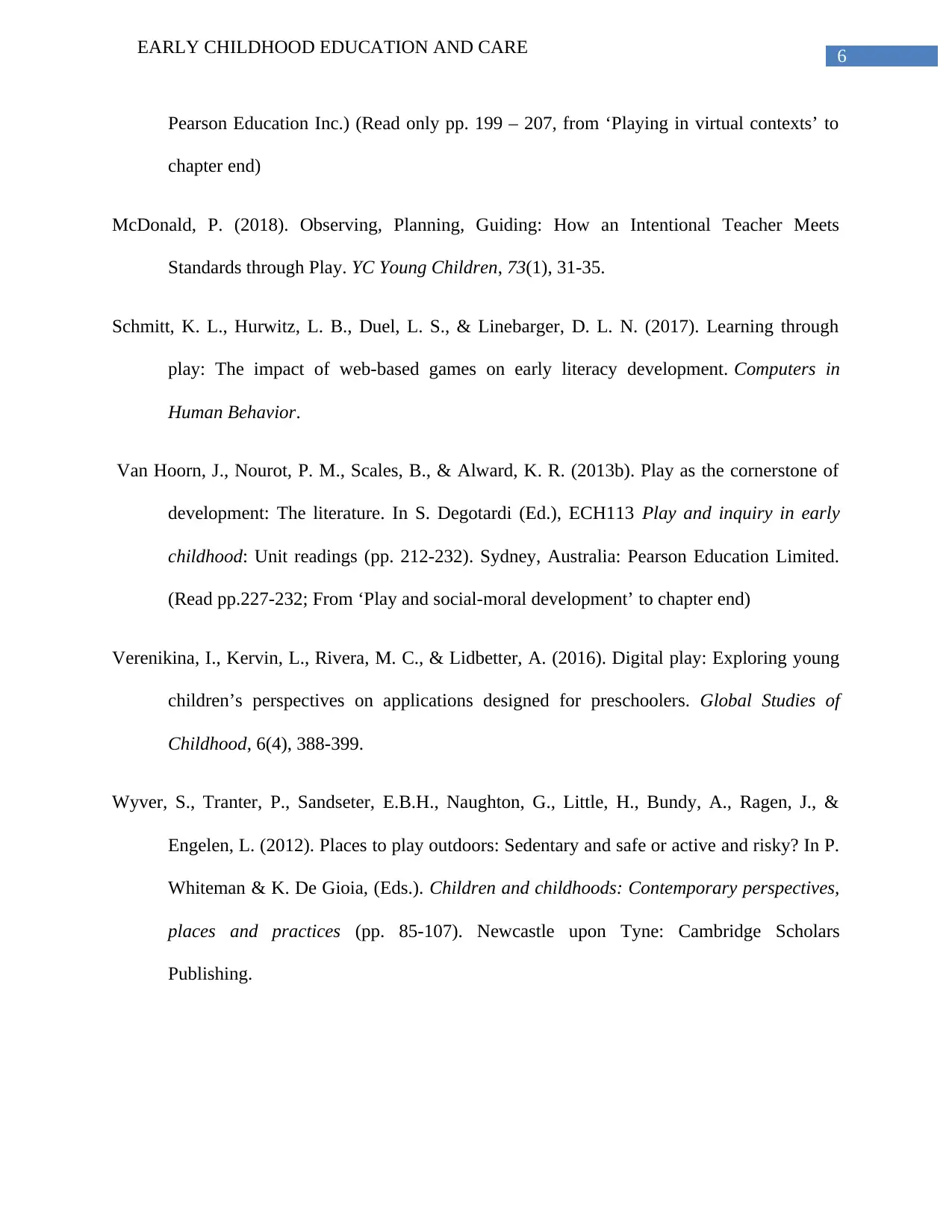
6EARLY CHILDHOOD EDUCATION AND CARE
Pearson Education Inc.) (Read only pp. 199 – 207, from ‘Playing in virtual contexts’ to
chapter end)
McDonald, P. (2018). Observing, Planning, Guiding: How an Intentional Teacher Meets
Standards through Play. YC Young Children, 73(1), 31-35.
Schmitt, K. L., Hurwitz, L. B., Duel, L. S., & Linebarger, D. L. N. (2017). Learning through
play: The impact of web-based games on early literacy development. Computers in
Human Behavior.
Van Hoorn, J., Nourot, P. M., Scales, B., & Alward, K. R. (2013b). Play as the cornerstone of
development: The literature. In S. Degotardi (Ed.), ECH113 Play and inquiry in early
childhood: Unit readings (pp. 212-232). Sydney, Australia: Pearson Education Limited.
(Read pp.227-232; From ‘Play and social-moral development’ to chapter end)
Verenikina, I., Kervin, L., Rivera, M. C., & Lidbetter, A. (2016). Digital play: Exploring young
children’s perspectives on applications designed for preschoolers. Global Studies of
Childhood, 6(4), 388-399.
Wyver, S., Tranter, P., Sandseter, E.B.H., Naughton, G., Little, H., Bundy, A., Ragen, J., &
Engelen, L. (2012). Places to play outdoors: Sedentary and safe or active and risky? In P.
Whiteman & K. De Gioia, (Eds.). Children and childhoods: Contemporary perspectives,
places and practices (pp. 85-107). Newcastle upon Tyne: Cambridge Scholars
Publishing.
Pearson Education Inc.) (Read only pp. 199 – 207, from ‘Playing in virtual contexts’ to
chapter end)
McDonald, P. (2018). Observing, Planning, Guiding: How an Intentional Teacher Meets
Standards through Play. YC Young Children, 73(1), 31-35.
Schmitt, K. L., Hurwitz, L. B., Duel, L. S., & Linebarger, D. L. N. (2017). Learning through
play: The impact of web-based games on early literacy development. Computers in
Human Behavior.
Van Hoorn, J., Nourot, P. M., Scales, B., & Alward, K. R. (2013b). Play as the cornerstone of
development: The literature. In S. Degotardi (Ed.), ECH113 Play and inquiry in early
childhood: Unit readings (pp. 212-232). Sydney, Australia: Pearson Education Limited.
(Read pp.227-232; From ‘Play and social-moral development’ to chapter end)
Verenikina, I., Kervin, L., Rivera, M. C., & Lidbetter, A. (2016). Digital play: Exploring young
children’s perspectives on applications designed for preschoolers. Global Studies of
Childhood, 6(4), 388-399.
Wyver, S., Tranter, P., Sandseter, E.B.H., Naughton, G., Little, H., Bundy, A., Ragen, J., &
Engelen, L. (2012). Places to play outdoors: Sedentary and safe or active and risky? In P.
Whiteman & K. De Gioia, (Eds.). Children and childhoods: Contemporary perspectives,
places and practices (pp. 85-107). Newcastle upon Tyne: Cambridge Scholars
Publishing.
1 out of 7
Related Documents
Your All-in-One AI-Powered Toolkit for Academic Success.
+13062052269
info@desklib.com
Available 24*7 on WhatsApp / Email
![[object Object]](/_next/static/media/star-bottom.7253800d.svg)
Unlock your academic potential
Copyright © 2020–2025 A2Z Services. All Rights Reserved. Developed and managed by ZUCOL.




